Catholic Customs
 |
 |
 |
 |
 |
 |
 |
Lammas Day:
Celebrating Harvests of Souls & Wheat
"Glorious chains! never will ye make Peter's successors tremble any more than Peter himself; before the Herods and Neros and Caesars of all ages, ye will be the guarantee of the liberty of souls." (1)
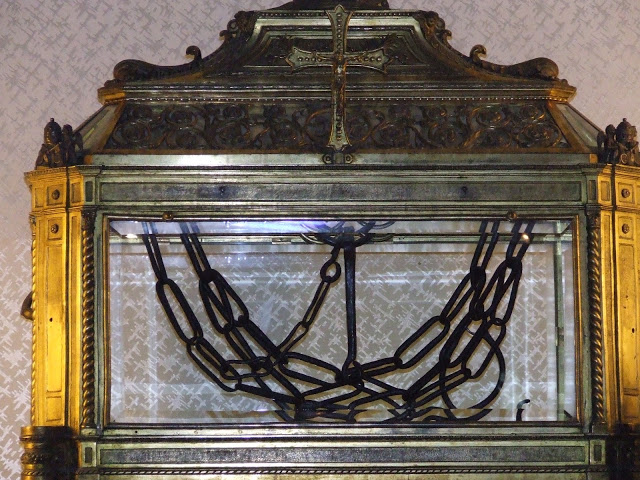
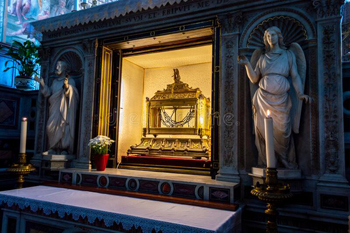 It is with these grand words that Dom Guéranger begins his entry for the great feast that begins the month of August: the Feast of St. Peter's Chains. The origin of this feast honoring the chains that bound St. Peter is so ancient that it "is lost in the darkness of the ages." (2) Indeed, it would seem that veneration for these sacred chains is something so natural to a Catholic that it can be found in every true Catholic heart.
It is with these grand words that Dom Guéranger begins his entry for the great feast that begins the month of August: the Feast of St. Peter's Chains. The origin of this feast honoring the chains that bound St. Peter is so ancient that it "is lost in the darkness of the ages." (2) Indeed, it would seem that veneration for these sacred chains is something so natural to a Catholic that it can be found in every true Catholic heart.
These holy relics are preserved in the Basilica of San Pietro in Vincoli (St. Peter in the Chains) also known as the Basilica Eudoxiana, set on the highest of the seven hills of Rome. Empress Eudoxia had the Basilica built in the fifth century to house the sacred Chains, which became the source of countless miracles. The feast day of August 1 commemorated the grand dedication of the Basilica.
The English people had such devotion to this feast that there is even a chapel in the Tower of London dedicated to St. Peter ad Vinculis. In the past, every family gave one penny to the Pope on this day as an annual tithe that became known as Denarius Sancti Petri (St. Peter's Penny or Peter's Pence).
The feast day of August 1 corresponded with the ancient British and Irish harvest festival of the "first-fruits" of the field. Instead of abolishing these old celebrations, the Church encouraged them, instilling a new meaning into them by incorporating them into the liturgical feast days.
In this way, the people gave thanks to God for the beginning of the harvest as they rendered homage to St. Peter. Peter's connection to the harvest is quite fitting: He was the Church's leader from her very beginning and brought 3,000 people into the Church on that first Pentecost Day alone. What a grand harvest did our first Pontiff reap!
God has indeed arranged the seasons most fittingly, for this whole month of August is filled with a rich array of Saints' feast days that reflect in their abundance and splendor the earthly harvest that filled our Forefathers' barns with its fruits.
Giving thanks for a fruitful harvest
Lammas was the popular name for the first of August amongst the Anglo-Saxons. Lammas has often mistakenly been assumed to mean "lamb-mass," referring to the obligation of feudatories of the Cathedral of St. Peter ad Vinculis at York to each bring a lamb to the Cathedral at the time of the high Mass on August 1.
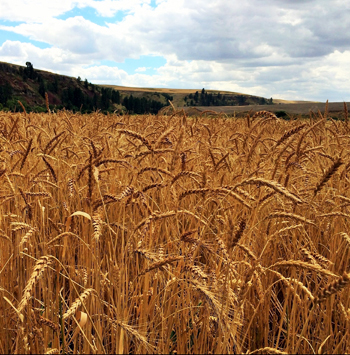 The more common practice, however, was for peasants to bring the first-cut sheaves of grain (known as "Lammas wheat") and bread made from this grain to the church to be blessed and offered in thanksgiving for a fruitful harvest.
The more common practice, however, was for peasants to bring the first-cut sheaves of grain (known as "Lammas wheat") and bread made from this grain to the church to be blessed and offered in thanksgiving for a fruitful harvest.
The true meaning of Lammas comes from this custom, as one can ascertain from the Old English name for the feast, hlafmaesse, which means "loaf-mass." In many areas of the British Isles, the sheaves of "Lammas wheat" were used to adorn the church doors and some of the blessed loaves were brought home to be shared at the celebratory meal that followed the Mass.
When reckoning dates or making plans for the coming year, Lammas Day was an important reference point. In many areas, Lammas Day was kept as one of the four cross-quarter days of the year, the common day to settle debts, pay rent and change jobs or houses. Masters traditionally gave glove-silver to their servants, money they commonly used to purchase gloves.
Lands set aside for growing early crops or hay during the Spring and early Summer months were called "Lammas Lands." These "Lammas Lands" were closed in with fences around Candlemas (February 2) to prevent animals from trampling on or eating the harvest.
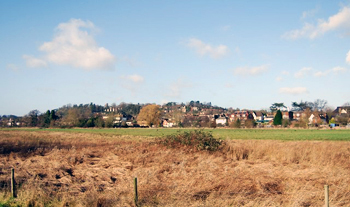
 '
The fences were taken down on Lammas Day to open the fields for the common grazing of sheep and cattle until the next Spring when they would again be closed. Every castle, townhouse and cottage honored the privileges of free pasturage in the "Lammas Lands," and the day's celebrations recalled this special bond based on that ancient privilege that united the people.
'
The fences were taken down on Lammas Day to open the fields for the common grazing of sheep and cattle until the next Spring when they would again be closed. Every castle, townhouse and cottage honored the privileges of free pasturage in the "Lammas Lands," and the day's celebrations recalled this special bond based on that ancient privilege that united the people.
Lammas Day was indeed a day of great rejoicing, for the promises of Spring were fulfilled and the people could once again mill fresh flour from the newly harvested grain and enjoy bread in abundance. It was joy and gratitude to God for these first fruits of the successful harvest that inspired the harvest celebrations, which continued until harvest end in September or October.
Feasts and merry fairs filled the land of England as the people celebrated the harvest and Lammas Day with due festivity. In Ireland, the people of small villages met at a chosen place in a field or by a well or stream to enjoy festivities that lasted into the late hours of the night. Plentiful food – new potatoes, fresh berries and freshly baked bread – was brought for everyone to enjoy the harvest fruits.
After the feast, the young men and boys competed in feats of strength, races and games while the girls and young women picked flowers and berries. As evening drew nigh, the men brought out their musical instruments to accompany the singing and dancing by the light of a bonfire.
This beautiful feast shows forth the grandeur of God in all of His works and how He perfectly unites the harvests and labors of different peoples with feast days, thus allowing the people to see the natural year through the eyes of the Church.
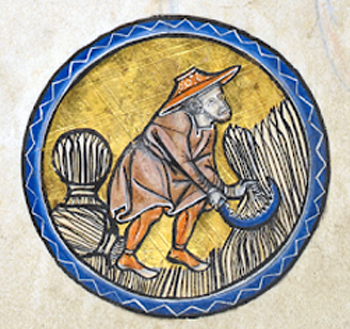
Sources:

Posted July 29, 2022

The sacred chains of St. Peter in their reliquary

These holy relics are preserved in the Basilica of San Pietro in Vincoli (St. Peter in the Chains) also known as the Basilica Eudoxiana, set on the highest of the seven hills of Rome. Empress Eudoxia had the Basilica built in the fifth century to house the sacred Chains, which became the source of countless miracles. The feast day of August 1 commemorated the grand dedication of the Basilica.
The English people had such devotion to this feast that there is even a chapel in the Tower of London dedicated to St. Peter ad Vinculis. In the past, every family gave one penny to the Pope on this day as an annual tithe that became known as Denarius Sancti Petri (St. Peter's Penny or Peter's Pence).
The feast day of August 1 corresponded with the ancient British and Irish harvest festival of the "first-fruits" of the field. Instead of abolishing these old celebrations, the Church encouraged them, instilling a new meaning into them by incorporating them into the liturgical feast days.
In this way, the people gave thanks to God for the beginning of the harvest as they rendered homage to St. Peter. Peter's connection to the harvest is quite fitting: He was the Church's leader from her very beginning and brought 3,000 people into the Church on that first Pentecost Day alone. What a grand harvest did our first Pontiff reap!
God has indeed arranged the seasons most fittingly, for this whole month of August is filled with a rich array of Saints' feast days that reflect in their abundance and splendor the earthly harvest that filled our Forefathers' barns with its fruits.
Giving thanks for a fruitful harvest
Lammas was the popular name for the first of August amongst the Anglo-Saxons. Lammas has often mistakenly been assumed to mean "lamb-mass," referring to the obligation of feudatories of the Cathedral of St. Peter ad Vinculis at York to each bring a lamb to the Cathedral at the time of the high Mass on August 1.

Thanking God for the successful harvest of wheat
The true meaning of Lammas comes from this custom, as one can ascertain from the Old English name for the feast, hlafmaesse, which means "loaf-mass." In many areas of the British Isles, the sheaves of "Lammas wheat" were used to adorn the church doors and some of the blessed loaves were brought home to be shared at the celebratory meal that followed the Mass.
When reckoning dates or making plans for the coming year, Lammas Day was an important reference point. In many areas, Lammas Day was kept as one of the four cross-quarter days of the year, the common day to settle debts, pay rent and change jobs or houses. Masters traditionally gave glove-silver to their servants, money they commonly used to purchase gloves.
Lands set aside for growing early crops or hay during the Spring and early Summer months were called "Lammas Lands." These "Lammas Lands" were closed in with fences around Candlemas (February 2) to prevent animals from trampling on or eating the harvest.

Lammas lands in the village of Godalming
 '
'Lammas Day was indeed a day of great rejoicing, for the promises of Spring were fulfilled and the people could once again mill fresh flour from the newly harvested grain and enjoy bread in abundance. It was joy and gratitude to God for these first fruits of the successful harvest that inspired the harvest celebrations, which continued until harvest end in September or October.
Feasts and merry fairs filled the land of England as the people celebrated the harvest and Lammas Day with due festivity. In Ireland, the people of small villages met at a chosen place in a field or by a well or stream to enjoy festivities that lasted into the late hours of the night. Plentiful food – new potatoes, fresh berries and freshly baked bread – was brought for everyone to enjoy the harvest fruits.
After the feast, the young men and boys competed in feats of strength, races and games while the girls and young women picked flowers and berries. As evening drew nigh, the men brought out their musical instruments to accompany the singing and dancing by the light of a bonfire.
This beautiful feast shows forth the grandeur of God in all of His works and how He perfectly unites the harvests and labors of different peoples with feast days, thus allowing the people to see the natural year through the eyes of the Church.

Sources:
- Bonnie Blackburn and Leofranc Holford-Strevens, The Oxford Companion to the Year (New York: Oxford University Press, 1999).
- Katherine Burton and Helmut Ripperger, Feast Day Cookbook (Catholic Authors Press, 2005).
- T.F. Thiselton-Dyer, British Popular Customs, Present and Past; Illustrating the Social and Domestic Manners of the People (London: George Bell and Sons, 1876).
- Steve Roud, The English Year (Penguin Books: 2006).
- William S. Walsh, Curiosities of Popular Customs and of Rites, Ceremonies, Observances, and Miscellaneous Antiquities (Philadelphia: J. B. Lippincott Company, 1898).
- https://www.thebookofdays.com/months/aug/1.htm
- https://www.irishcultureandcustoms.com/ACustom/Harvest.html

Posted July 29, 2022
______________________
_____________________
 |
 |
 |
 |
 |
 |


